Both young and old people face the problem of corns, and, as a rule, they are in no hurry to seek help. However, corns require treatment, with their development, soreness and other inconveniences can be observed. To quickly get rid of corns and calluses on the feet (see photo below), they resort to medications and folk remedies.
Types of corns and places of their localization
The feet require careful grooming. If it is insufficient or incorrect, calluses may appear, which are not so easy to get rid of.
Corns (calluses) are of several types:
- Plantar - occur with mechanical damage (irritation) and in the presence of cracks. They affect a fairly large part of the foot or are located at the base of the toes.
- Finger - occur on the big toe.
- Rod - have a root that penetrates deep under the skin. The most common cause is a virus. This type gives a person painful sensations. To remove such a callus, modern methods of removal are used, since such a callus cannot be cured at home.
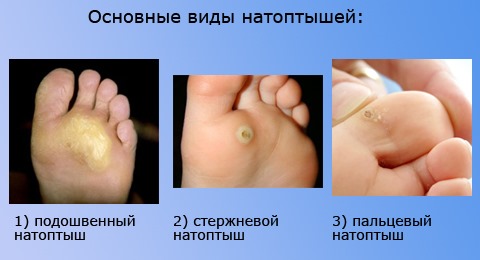
- excess weight;
- staying on your feet for a long time;
- flat feet;
- improperly selected shoes;
- improper foot care or lack thereof;
- diabetes.
Which doctor to contact
When corns appear, you need to consult an orthopedist. In some cases, in order to find out the root cause of the appearance of corns, it takes some time (for example, to pass tests or visit additional specialists).
Therefore, to relieve pain, the doctor may temporarily prescribe:
- anti-callus plaster;
- keratolytic cream.
In the most advanced cases, the doctor prescribes surgical removal of the corns.
During the operation, the surgeon dries out only the damaged part of the tissue by removing the rod.
Cryodestruction
Cryodestruction - involves exposure to the corns or corn with liquid nitrogen. At a temperature of -196 degrees, keratinized tissue dies off.
Advantages and disadvantages of this type of removal:
- Fast - the procedure lasts from 30 seconds to 2 minutes.
- Painlessness - the only thing that can be felt during the period is a little cold. Anesthesia is not required.
- Cryodestruction can be performed for children and adults.
- Low risk of infection - dead tissue will begin to peel off within 2-3 days after the procedure. After the crust falls off, there will be a new layer of skin underneath.
- Cryodestruction does not imply any trauma - under the influence of liquid nitrogen, the vessels are "sealed", so the risk of various bleeding is excluded.
- No scarring after healing.
Of the shortcomings, only unpleasant sensations can be distinguished during the rehabilitation period.
In addition to all the advantages, this procedure also has contraindications:
- intolerance to low temperatures (which is extremely rare);
- flattening of corns on a large area of the skin.When there are several large corns on the foot next to each other, and they merge into one, cryodestruction is impossible, since such a wound will heal for a very long time.
After removal of the callus, wound healing creams are usually prescribed, as well as wearing a special patch to avoid the reappearance of corns. The procedure is carried out only in a clinic by a dermatologist. Prices in different regions range from 700 rubles. up to 2000 rubles, which makes the procedure relatively affordable.

 Don't miss the most popular column article: Laser hair removal on the face and body - how it is carried out, effectiveness, before and after photos, contraindications.
Don't miss the most popular column article: Laser hair removal on the face and body - how it is carried out, effectiveness, before and after photos, contraindications.Laser destruction
Core calluses are also removed using laser destruction. The procedure is painless, but unlike cryodestruction, this method involves the use of pain relievers. The laser acts only on hardened skin, without touching healthy tissue. The recovery period takes several days.
In the early stages of the appearance of corns, laser removal is not required. This procedure is indicated for the appearance of core calluses, as well as infected painful corns. If a person has a circulatory disorder, there is a high risk of corns infection.
Such areas must be removed using laser destruction or another procedure recommended by a doctor. When removed by a laser, keratinized cells are heated to high temperatures and, as a result, evaporated. If the callus or corns did not have a rod, then after this procedure the skin will remain even and smooth. Otherwise, minor abrasions and wounds may temporarily remain on the foot.
The removal process takes no more than 2-3 minutes. After the procedure, the skin area is treated with disinfectants. The likelihood of reappearance of corns is zero.
Laser destruction has the following advantages:
- the risk of infection is excluded;
- fast recovery period after the procedure;
- no bleeding;
- the ability to remove corns in 1 session;
- painlessness;
- no scars after healing;
- the risk of reappearance is reduced to zero.
There are only two disadvantages:
- a number of contraindications for this procedure (pregnancy, breastfeeding, diabetes mellitus, malignant tumors, low immunity);
- more expensive method in comparison with others.
Creams and ointments
Calluses on the feet, treatment, quick disposal (photo will be posted below) from them occurs thanks to various creams and ointments, it is recommended to lubricate with such means.
Most Popular:
- Salicylic ointment - is prescribed as the main drug. It is effective in the treatment of calluses, warts, corns, soothes inflamed skin, kills pathogenic bacteria. The active ingredient is salicylic acid, thanks to which the corns quickly soften. In addition, the ointment is keratolic, that is, it helps to exfoliate the skin, making it smooth and restoring its appearance. It cannot be used in infancy, as well as in case of renal failure and individual intolerance. Side effects are very rare. As a rule, this is a slight redness and itching, a rash on the skin is possible. If side symptoms are identified, treatment with salicylic ointment should be discontinued. Price - 20-30 rubles.
- Chinese corn plaster - red plates on which the medicinal ointment is distributed. The active substance is a compound of salicylic acid and phenol. The tandem of these two substances has an antibacterial, anti-inflammatory effect, and also relieves itching. Contraindications to the use of the patch are a violation of the integrity of the skin, trauma and individual intolerance.
Verrukacid. Available in dark bottles. It is forbidden to use the ointment for children under 7 years old and in the case when the total area of the affected areas reaches 20 cm2.In an interesting position, the use of the drug is allowed if the benefit to the mother outweighs the potential risk to the fetus. Side effects such as redness and swelling may occur, which usually does not require a visit to a doctor, as it goes away on its own. Price from 200 to 300 rubles.
- Balm for feet Balzamed. The composition contains such components as vitamin A, E, provitamin B5 (panthenol), jojoba oil, avocado, urea. Regular use of this ointment helps to make the skin more elastic, even. The skin on the legs becomes healthy and well-groomed. The price varies between 250-400 rubles.
- Antimozolinum cream. Urea and lactic acid in the composition moisturize the skin well and help soften the calloused tissues. The cream has no contraindications and is recommended for regular use. The price ranges from 80 rubles. up to 150 rubles.
- Combined ointment of 3 components: petroleum jelly, salicylic and benzoic acid. It cannot be applied if the integrity of the skin is violated, as well as if there is sensitivity to one of the components.
- Beeswax, mixed with lemon juice and propolis. Contraindicated in people allergic to beeswax.
- Vishnevsky ointment. The active substance is xeroform and birch tar, the auxiliary substances are fish oil or castor oil. Xeroform has antimicrobial, astringent and drying effect. It is allowed to be applied to large areas of the skin. Moreover, they use it at least 3 times a day. The ointment is applied to gauze or cotton swab and applied to the corn. Application in childhood, as well as during pregnancy and lactation is prescribed after consultation with a specialist. With prolonged use of the ointment, such undesirable phenomena as urticaria, skin edema, itching were noted. The approximate price is 20-40 rubles.
In the composition of creams and ointments for corns, you can also find a component such as glycolic acid, which has antimicrobial and antiseptic effect.
The use of anti-ash creams during pregnancy is not contraindicated, but there are some exceptions.
For example, the use of salicylic ointment is not recommended because salicylic acid is absorbed into the bloodstream. If, nevertheless, there is an urgent need to use this remedy, then pregnant women are allowed to use the ointment no more than 1 g per day.
Callus plaster
Calluses on the feet: treatment, quick disposal (the photo can be viewed) from them can occur with the help of corn plasters, and can be treated at home. The composition of the patch, which includes softening, softening and anti-inflammatory components, determines the properties of the patch. They have antifungal, keratolytic and antiseptic effects.
Before applying the patch, the skin must be cleaned, degreased and dried. Glue the patch only on the sore area. You need to wear a bandage for 1-2 days without removing it, then you need to change it to a new one. Contraindications to the use of corn plasters are various skin lesions.
Corn plasters vary in shape:
- round;
- oval;
- triangular;
- square.
Some manufacturers offer patches for the little toe, for calluses between the toes, for small and large calluses, with special pads for the base of the big toe and the arch of the foot. With all the pluses, plasters also have minuses. The composition used in the manufacture affects not only the diseased skin area, but also the healthy one.
This can result in reactions including redness and itching of the skin. In addition, the plasters quickly deteriorate during storage. If core calluses appear, then acids and alkali must be present in the plaster to "dissolve" the corns. You need to use such patches for a longer period. Today there are a lot of companies producing corn plasters.
The most famous of them:
- Salipod - plasters of a domestic manufacturer.Available in the form of rectangles, as well as a large fixing plaster. The composition contains substances such as salicylic acid, sulfur, rosin and lanolin. This patch is not recommended for pregnant women, people with kidney failure, children under 14 years old, people with diabetes and various tumors, and also if the patch, in addition to the corns, will capture moles. If during application such undesirable effects as redness, itching and burning appear, this method of treatment should be abandoned. The price in different regions varies from 50 rubles. up to 200 rubles
- Compeed plasters - the manufacturer produces silicone plasters for various types of corns and corns: both wet and dry. You can choose exactly the shape that is needed so that it is convenient to stick them not only on the legs, but also on the hands. The active ingredient in these patches is salicylic acid. The price of these plasters is 300-500 rubles.
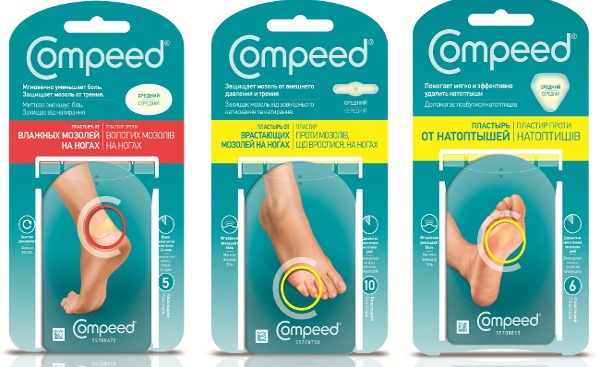
- pain relief of calluses;
- the patch provides protection against infection and cracks;
- waterproof (you can take a shower with it);
- softens calluses and corns;
- breathable (the skin "breathes").
Other famous patches:
- Plaster URGO - the manufacturer produces adhesive plasters of various shapes. The active ingredient is salicylic acid. To achieve the therapeutic effect, 3-4 applications of the URGO patch are required.
- Adhesive plaster Cosmos - the composition is similar to the Compeed plasters. Price range from 100 rubles. up to RUB 300

 Don't miss the most popular column article: Morning exercises for those over 40, 50. Gymnastics exercises for weight loss, video tutorials.
Don't miss the most popular column article: Morning exercises for those over 40, 50. Gymnastics exercises for weight loss, video tutorials.Pedicure socks
Calluses on the feet - treatment, quick disposal (photos will be posted later in the article) from painful corns is carried out using convenient home methods - it can be eliminated with pedicure socks. They are produced in the form of shoe covers made of transparent film. The active ingredient is lactic acid, and socks are impregnated with it.
The composition may also contain hyaluronic acid, castor oil, soy oil. Thanks to all these components, the effect of deep peeling and moisturizing of the skin of the feet is achieved. The process of removing corns with this remedy is quite long, but the result is comparable to a salon procedure. It is necessary to carry out such a procedure at home according to the instructions.
The general rules are as follows:
- wash, steam and treat feet with pumice stone;
- open the socks and pour the solution into them;
- carefully put on pedicure socks, and on top another pair of cotton socks;
- keep the specified time;
- wash off the remains with warm water.
The peeling action continues after rinsing. The process takes 5-7 days. At this time, the feet will not look very aesthetically pleasing, since the old skin will be actively replaced by the new one. Do not tear off peeling skin so as not to damage the new one. As a last resort, you can cut it off with nail scissors.
The result after such a deep peeling lasts for 3-4 months, then you can repeat this procedure as needed.
Baths
Calluses on the feet - treatment, quick disposal (see the photo in the article) from them can be carried out with the help of home improvised means - they are treated with baths.
Here are the most used recipes:
- Mix 3 tsp in heated water. soda and 1 tsp. grated soap. The legs are steamed for 30 minutes, then the steamed keratinized skin is treated with a pumice stone or a brush.
For the treatment of corns on the feet at home, you can use a bath. use - The whey or milk is slightly heated (up to 40 degrees) and the legs are lowered there for 30 minutes. Then the feet are wiped dry and a cream made from castor oil and glycerin, combined in a 1: 1 ratio (the cream is made independently), is distributed.
- For 1 liter of water you need 2 tsp. peroxide. Stir, keep the feet in the solution for 40 minutes. Then they wipe their feet and spread the greasy cream.
Compresses
Compresses and lotions are no less popular for removing corns:
- Lotions with aloe juice - to the corns, you need to attach a freshly cut aloe leaf at night and secure it with adhesive plaster. After waking up in the morning, you should carefully treat the problem area with a pumice stone.
- Lotions with lemon - Before going to bed, you should steam your feet, then wipe them dry. At night, a slice of lemon with a peel is applied to the problem area. You need to repeat this action for 3-4 days. Then you need to steam your feet again and rub them with a pumice stone or a coarse brush.
- Lotions with potatoes - you need to grate one potato on a fine grater. The resulting mass is wrapped in a piece of gauze and squeezed a little. It should be applied to the sore spot at night. In the morning, the skin will become pliable and the callus can be removed.
- Onion compress - the cleaned head is cut into half rings, then applied to the corn, a bag and a warm sock are put on top. The compress should be left overnight. Then the skin is washed with warm water and the peeled skin is carefully removed with a pumice stone. After the procedure, it is recommended to moisturize the skin with a cream.
- Compress with propolis - it is necessary to soften the propolis, then apply it to the corns and wrap it with polyethylene. A warm sock is put on top of the bag. You need to wear a compress without removing it all day. Softened skin will be easy to remove after such a compress.
- Compress with celandine - The leaves of the plant must be peeled and ground in a blender. The resulting mixture is applied to the sore spot. Then they wrap the foot with a plastic bag, put on a sock and leave it overnight. In the morning, they wash their feet and rub problem areas with a pumice stone. If the corns have not gone away from the first application, the procedure should be repeated until they disappear completely.
Callus masks
Masks help to easily get rid of corns between the fingers and on the little fingers:
- It is required to take 2 tbsp. flaxseeds and 100 g of potato peel, pour the ingredients with water and cook over the fire for half an hour. The resulting mixture must be cooled and applied to the affected area for 30 minutes. This time will be enough for the skin to soften and can be removed without problems.
- You can make an ivy mask by boiling the plant for 10 minutes. Then the broth should be applied to the corns for 30 minutes. After that, be sure to lubricate the feet with a fat cream.
- Take in a 1: 1: 1 ratio of tar, saltpeter and sugar. The mass is well mixed and distributed in an even layer, left for 1 hour. Then wash off the remnants of the mask with warm water and rub the corn with a brush. After the procedure, moisturize the skin with a fat cream.
Using oils for calluses
Traditional medicine knows that you can get rid of corns with the help of oils. To do this, take olive, linseed, corn and castor oils. They soften the skin and help get rid of painful sensations.
To remove corns in this way, you will need:
- carry out hygiene procedures for the feet and steam them;
- soak cotton socks with oil and put them on;
- wrap with polyethylene;
- put on another cotton socks and leave for 8-10 hours;
- remove socks and treat the skin with a pumice stone or a coarse brush;
- smear your feet with a fat cream.
Tea tree oil is also used for corns. It has antibacterial properties. It should be applied pointwise, with a cotton swab, to the affected area in the morning and evening until the callus disappears completely.
How to properly get rid of corn with a core
With constant wearing of tight and improperly selected shoes, wet calluses appear. Over time, this area of skin becomes rough and the callus becomes dry. This process takes place very quickly, but getting rid of such a callus just as soon will not work. Dry corn can take root, which is why it is called core corn.
If the callus has recently appeared, then home remedies will come to the rescue. In the event that the coarsening is old, you can not do without going to the salon.You can remove the build-up with a laser, hardware pedicure and cryosurgery. All methods are completely painless.
How to quickly get rid of corns
Salon procedures will help to quickly cure and get rid of corns on the feet (photos are presented in the article). If the diseased area of the skin is not very rough, then procedures with compresses, masks, pedicure socks at home are suitable.
Prevention is important. The skin of the feet must be regularly moisturized and the correct shoes must be chosen, then the risk of new calluses will be minimized.
How to treat corns if they hurt
Even a common callus can be painful. Until the root cause of painful sensations is eliminated, all procedures will bring only temporary relief.
Here are some tips on how to temporarily relieve pain:
- cooling the area with a piece of ice, which will help relieve swelling and inflammation;
- the use of a corn plaster;
- the use of salicylic acid-based ointments and creams exfoliates rough tissues well;
- if the pain is very severe and interferes with movement, an anesthetic ointment (for example, Diprospan) can be applied.
Calluses and diabetes
Calluses often appear in people with diabetes, because with diabetes the body is dehydrated and the skin becomes dry and inelastic, as a result of which cracks appear. The body, including the legs, requires careful care. You can use a pumice stone or brush to remove calluses and corns, but never with a knife or blade.
Dibetics' wounds take a long time to heal, and any cut is a gateway for infection.
To avoid infection, you need to carefully observe foot hygiene:
- Feet should be washed every day, even if they are not dirty. When wiping, do not forget about the interdigital zones (the most bacteria accumulate there).
- Use moisturizers daily to avoid cracking.
- Socks, tights are changed daily, regardless of how dirty they are.
- Shoes are well ventilated, preventing moisture inside.
Calluses on the feet are treatable and quickly get rid of them (see photo), and the skin of the feet becomes beautiful and well-groomed. This requires paying attention to high-quality shoe selection and careful foot care.
Article design: Oksana Grivina
Video on how to treat calluses on the feet
Treatment of corns and cracks at home:

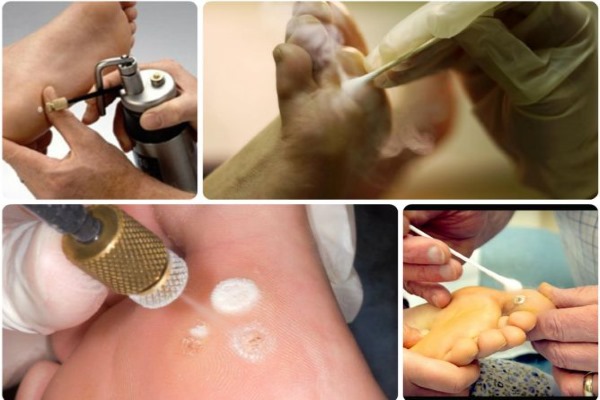
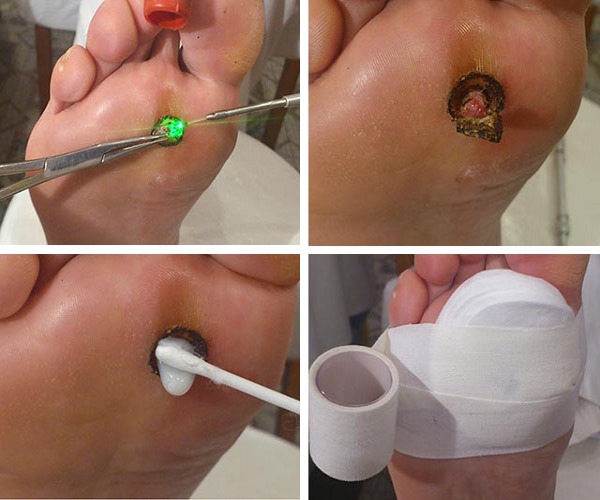
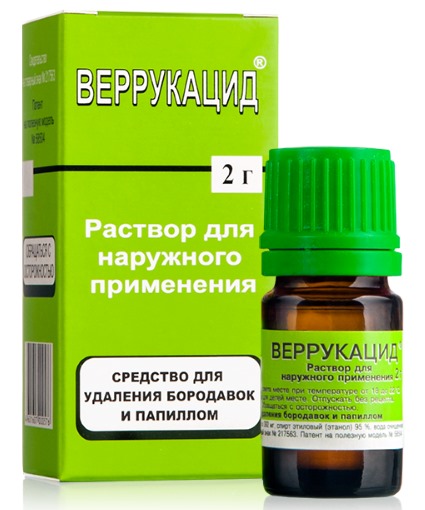
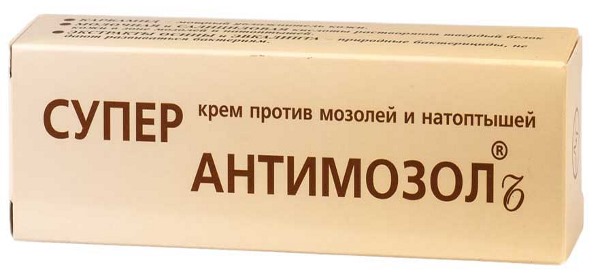
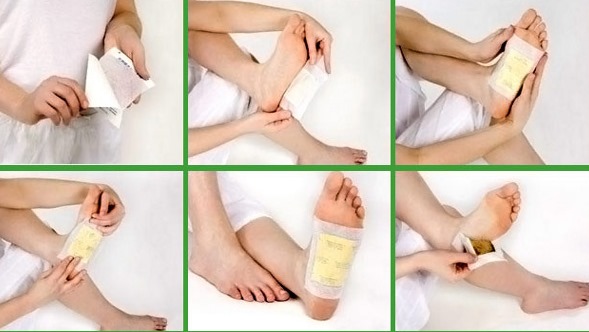
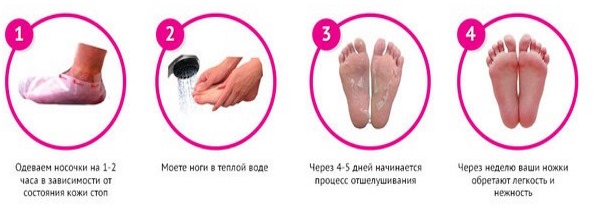
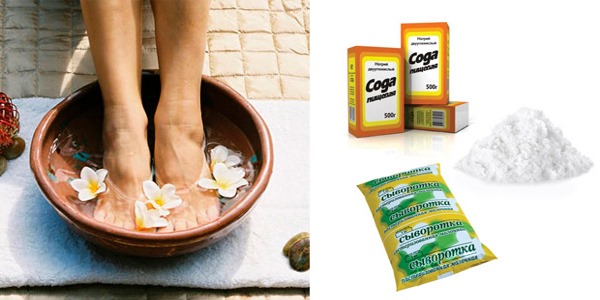
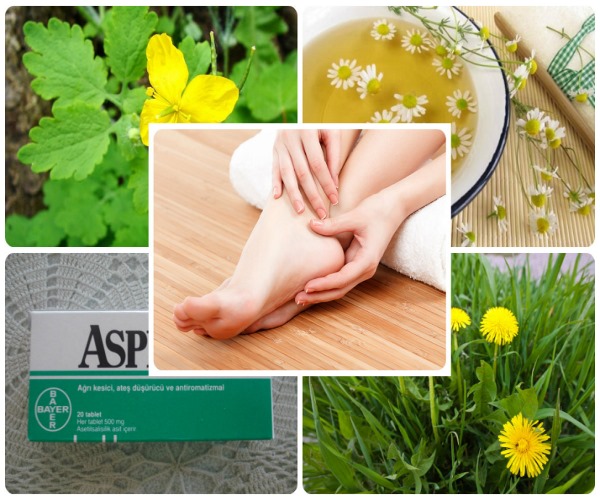

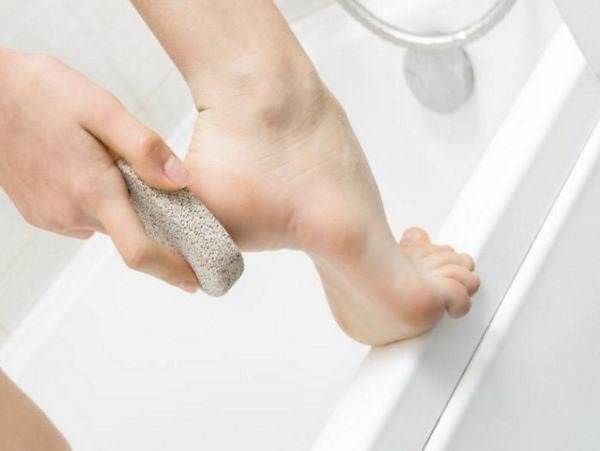
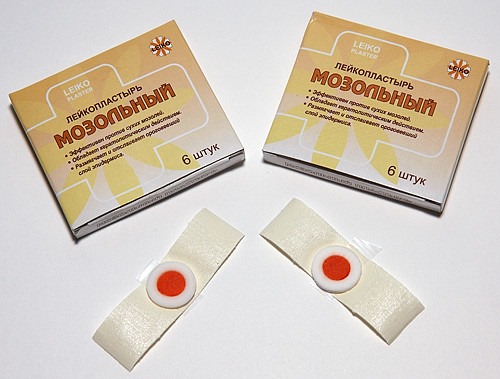
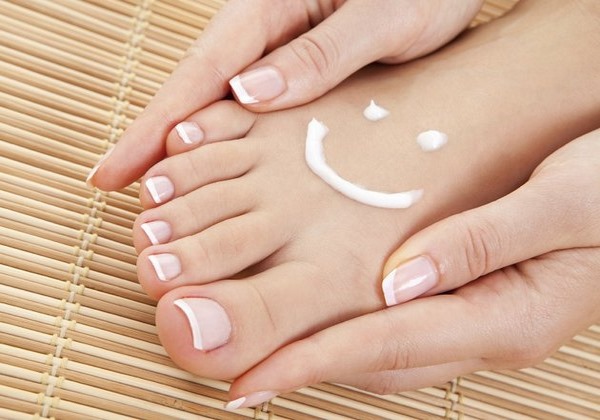
I am familiar with this problem. Special creams helped to cope with corns.
I get rid of corns with Uroderm ointment. She quickly puts the skin in order. I used to do it in the salon, now I don't go to salons. Why, if you can do the same at home.
My doctor prescribed Uroderm cream 30% and Aquapilling 40%. Said to alternate every other day. Today I started treatment.
I steam it with soda and salt, then I go through with a pumice stone and overnight with a thick layer of Burenka cream, it nourishes the skin well, softens it
Twins Tack Crack Cream helped me with cracks in my feet. The cream contains an active herbal complex in combination with allantoin and vitamin F, which stimulates the regeneration of skin cells, promotes healing of cracks and prevents the formation of corns. My skin became soft and elastic.
In our family, adults had corns with cracks on the heels that only did not use pumice, creams, baths, peroxide, etc., but fought with the consequence, not the cause, and the reason turned out to be that when for cooking, we used aluminum dishes, replaced the dishes with stainless steel and doused, the problem went away within 1 year, we periodically use only pumice.
Best regards, Alexey is a godly man.